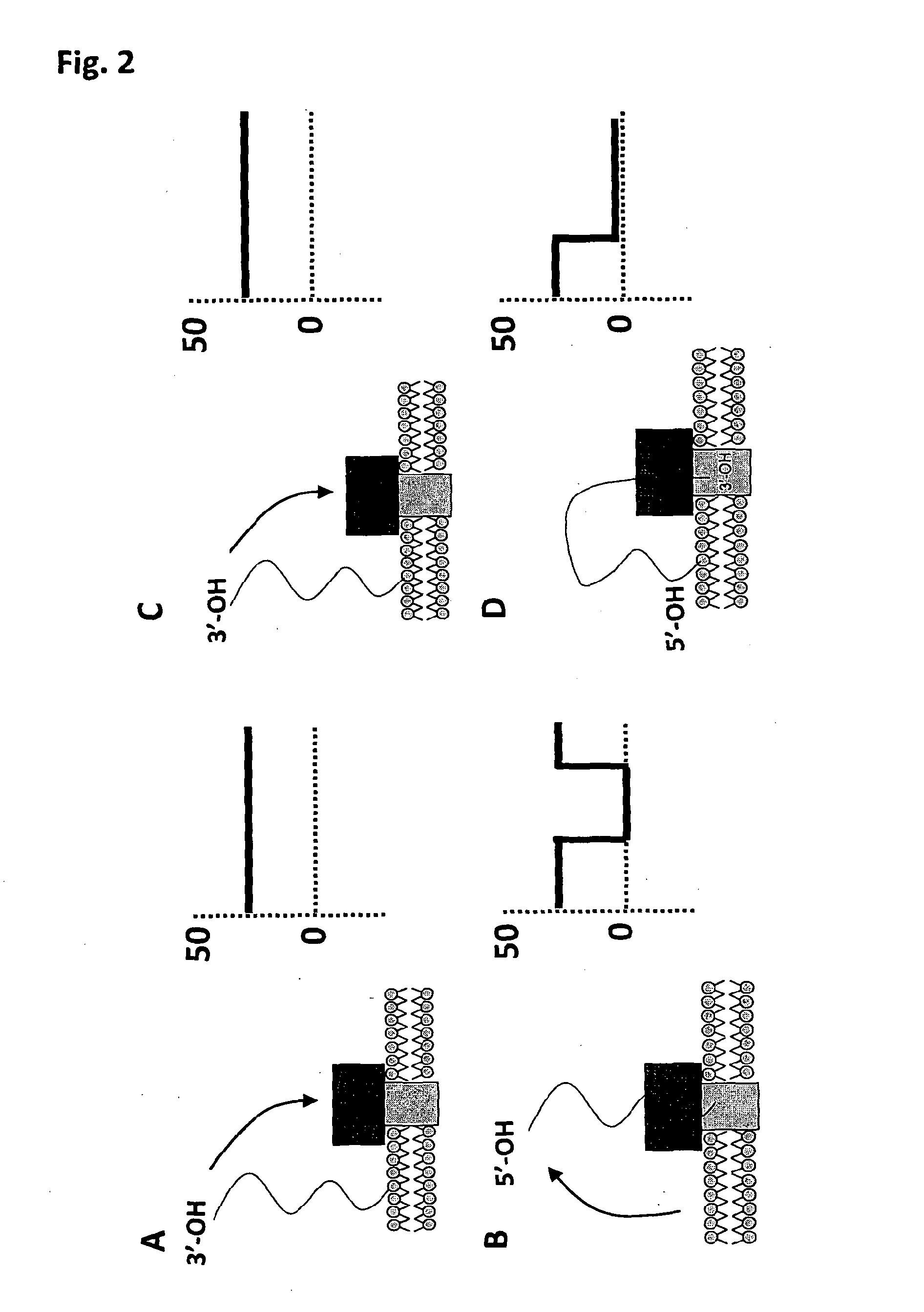Coupling method
a technology of coupling and analyte, applied in the direction of fluid pressure measurement, liquid/fluent solid measurement, peptide, etc., can solve the problem of limiting the concentration of polynucleotide, such as dna, and the disclosed increase in analyte detection is still well short of the step change required for ultra-sensitive detection and delivery, so as to prevent the detection of individual nucleotides, increase the duty cycle of sequencing system, and effectively increase the duty cycl
- Summary
- Abstract
- Description
- Claims
- Application Information
AI Technical Summary
Benefits of technology
Problems solved by technology
Method used
Image
Examples
example 1
1. Example 1
Exonuclease Sequencing
1.1 Materials and Methods
1.1.1 Materials and Oligonucleotides
[0281]Oligonucleotides were purchased from either ADTBio or IDTDNA. Details of the exact sequences and modifications can be found in the Table below (SEQ ID NOs 18 to 21).
Modification In-SEQSup-ter-LengthIDplierName5′nal3′(nt)SequenceNO:CodeONLAChol-——70TTTTTTTTT18ATDBio0692TEGTTTTTTTTTA8691TTTTTTTTTTTTTTTTTTTTTTTTTTTTTTTTTTTTTTTTTTTTTTTTTTTTONLAChol-——70AAAAAAAAA19ATDBio0682TEGAAAAAAAAAA887AAAAAAAAAAAAAAAAAAAAAAAAAAAAAAAAAAAAAAAAAAAAAAAAAAAAONLAChol-——70CCCCCCCCC20ATDBio0683TEGCCCCCCCCCA8874CCCCCCCCCCCCCCCCCCCCCCCCCCCCCCCCCCCCCCCCCCCCCCCCCCCCONLAStrep-——70TTTTTTTTT18IDT0693Btn:TTTTTTTTT60739014ssDNATTTTTTTTTTTTTTTTTTTTTTTTTTTTTTTTTTTTTTTTTTTTTTTTTTTTONLAStrep-——70TGTGTTCTA21IDT0694Btn:TGTCTTATT60739013ssDNACTTACTTCGTTATTCTTGTCTCTATTCTGTTTATGTTTCTTGTTTGTTAGCAONLA———70TTTTTTTTT18IDT0706TTTTTTTTT60692267TTTTTTTTTTTTTTTTTTTTTTTTTTTTTTTTTTTTTTTTTTTTTTTTTTTT
[0282]Recombinant Streptavidin, expre...
example 2
2. Example 2
Strand Sequencing
[0292]In addition to the work for attaching ssDNA to the lipid membrane for Exonuclease Sequencing, the technique can also be adapted to a Strand Sequencing approach. In Strand Sequencing, a portion of a polynucleotide strand is threaded through the nanopore under an applied potential. The strand is typically DNA or RNA, for example single stranded or double stranded DNA. Preferably the strand is single stranded DNA (ssDNA). The base residues comprised in the strand interact with the nanopore and a signal is generated that is characteristic of each residue. The strand is moved through the pore, causing variation to the signal. The signal can be used to infer the sequence of the DNA strand.
[0293]One embodiment of Strand Sequencing uses a protein pore embedded in a lipid membrane. Electrodes are placed either side of the lipid membrane in an electrolyte and a potential is applied across the system. Under the potential the polynucleotide translocates the po...
example 3
3. Example 3
More Strand Sequencing
[0310]In recent work, Phi29 DNA polymerase has been used to control the translocation of a DNA strand through α-hemolysin (Akeson et al., 2010, J Am Chem. Soc. 2010 Dec. 22; 132(50):17961-72.). Two modes of controlled movement of a DNA strand through a nanopore have been reported using Phi29 as a molecular motor, both methods relying on its action at the double / single stranded DNA juncture on a 5′-overhanging duplex. Movement can occur either by polymerisation from the priming strand that is hybridised opposite to the strand being interrogated or by an unzipping method where the priming strand is sequentially unhybridised from the strand being interrogated to reveal more and more of the targets sequence that was previously duplex DNA.
3.1 Materials and Methods
[0311]As presented for single stranded DNA, the tethering moiety can be varied to generate strands that display either a transient interaction with the bilayer or a more long duration tethering,...
PUM
| Property | Measurement | Unit |
|---|---|---|
| volume | aaaaa | aaaaa |
| voltage | aaaaa | aaaaa |
| voltage | aaaaa | aaaaa |
Abstract
Description
Claims
Application Information
 Login to View More
Login to View More - R&D
- Intellectual Property
- Life Sciences
- Materials
- Tech Scout
- Unparalleled Data Quality
- Higher Quality Content
- 60% Fewer Hallucinations
Browse by: Latest US Patents, China's latest patents, Technical Efficacy Thesaurus, Application Domain, Technology Topic, Popular Technical Reports.
© 2025 PatSnap. All rights reserved.Legal|Privacy policy|Modern Slavery Act Transparency Statement|Sitemap|About US| Contact US: help@patsnap.com



